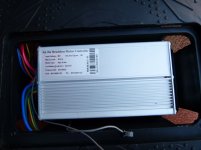Milou
1 W
Hi: I have a Chinese motorcycle scooter with a 48V DC to 12V DC Converter. There are three wires coming IN and OUT (Yellow, Black, Red). I traced each. Given their resources and output I am assuming as follows:
RED (Ignition, Instrument Panel, Controller) is the 48V input?
BLACK (Headlights, Horn, Instrument Panel, Controller, Kickstand [has safety switch], Battery) is the ground?
YELLOW (Headlights switch, 12V relay, Horn R switch, Horn L switch, Brake lever switch, Instrument Panel, Rear connector, Kickstand Switch) is the 12V output?
Would it be safe/easier to have the ground directly onto the frame with appropriate reference electrical source (battery) ground to the frame?
I would like to replace the DC to DC converter with a 12V xxxA battery of my own setup. I notice this not being the norm. Is there a logic/reason/safety issue with the separate setup (besides charging/maintaining another battery)? My desire is to play around with the motor controller modifications without worrying about the other electrical issue accessories.
Thanks in advance for replies. Regards JJ
RED (Ignition, Instrument Panel, Controller) is the 48V input?
BLACK (Headlights, Horn, Instrument Panel, Controller, Kickstand [has safety switch], Battery) is the ground?
YELLOW (Headlights switch, 12V relay, Horn R switch, Horn L switch, Brake lever switch, Instrument Panel, Rear connector, Kickstand Switch) is the 12V output?
Would it be safe/easier to have the ground directly onto the frame with appropriate reference electrical source (battery) ground to the frame?
I would like to replace the DC to DC converter with a 12V xxxA battery of my own setup. I notice this not being the norm. Is there a logic/reason/safety issue with the separate setup (besides charging/maintaining another battery)? My desire is to play around with the motor controller modifications without worrying about the other electrical issue accessories.
Thanks in advance for replies. Regards JJ



